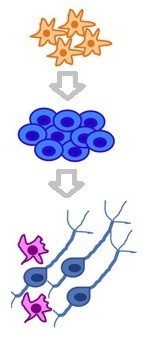 The development and optimization of methodology is crucial for successful introduction of stem cell therapies into the clinic. Nature Protocols and the Protocol Exchange contain recipe-style details to facilitate implementation of the latest stem cell methods in your laboratory. Nature Protocols contains peer-reviewed, commissioned and edited papers, whilst all scientists can upload their protocols to the open-access Protocol Exchange. All of our protocols in the stem cell research area are collated into our stem cell series. The Protocol Exchange can be searched to display all the protocols related to stem cells, with further refinement of the search criteria to display those related to papers in specific journals, such as protocols related to Nature papers.
The development and optimization of methodology is crucial for successful introduction of stem cell therapies into the clinic. Nature Protocols and the Protocol Exchange contain recipe-style details to facilitate implementation of the latest stem cell methods in your laboratory. Nature Protocols contains peer-reviewed, commissioned and edited papers, whilst all scientists can upload their protocols to the open-access Protocol Exchange. All of our protocols in the stem cell research area are collated into our stem cell series. The Protocol Exchange can be searched to display all the protocols related to stem cells, with further refinement of the search criteria to display those related to papers in specific journals, such as protocols related to Nature papers.
Selected below are recent protocols published in Nature Protocols, which aim to facilitate translation of stem cell research into the clinic. Image credit: derived from Zhu et al.
A 3D human neural cell culture system for modeling Alzheimer's disease
Young Hye Kim, Se Hoon Choi, Carla D'Avanzo, Matthias Hebisch, Christopher Sliwinski, Enjana Bylykbashi, Kevin J Washicosky, Justin B Klee, Oliver Brüstle, Rudolph E Tanzi & Doo Yeon Kim
Instructions for the generation and analysis of 3D human neural cell cultures, including the production of genetically modified human neural progenitor cells (hNPCs) with familial AD mutations, the differentiation of the hNPCs in a 3D matrix and the analysis of AD pathogenesis. This gives details of the model first described in Choi et al. (2014).
Reprogramming fibroblasts toward cardiomyocytes, neural stem cells and hepatocytes by cell activation and signaling-directed lineage conversion
Saiyong Zhu, Haixia Wang & Sheng Ding
Describes how to generate cardiomyocytes, neural stem cells and hepatocytes from fibroblasts using a cell activation and signaling-directed strategy.
Efficient derivation and inducible differentiation of expandable skeletal myogenic cells from human ES and patient-specific iPS cells
Sara M Maffioletti, Mattia F M Gerli, Martina Ragazzi, Sumitava Dastidar, Sara Benedetti, Mariana Loperfido, Thierry VandenDriessche, Marinee K Chuah & Francesco Saverio Tedesco
This describes how to to derive myogenic cells from human embryonic stem and induced pluripotent stem (iPS) cells, including human iPS cells cultured without feeder cells.
The in vitro generation of lung and airway progenitor cells from human pluripotent stem cells
Sarah X L Huang, Michael D Green, Ana Toste de Carvalho, Melanie Mumau, Ya-Wen Chen, Sunita L D'Souza & Hans-Willem Snoeck
This details a strategy for directed differentiation of hPSCs into developmental lung progenitors, and their subsequent differentiation into predominantly distal lung epithelial cells. It was established and optimised in Green et al. (2011) and Huang et al. (2014).
The generation of kidney organoids by differentiation of human pluripotent cells to ureteric bud progenitor–like cells
Yun Xia, Ignacio Sancho-Martinez, Emmanuel Nivet, Concepcion Rodriguez Esteban, Josep Maria Campistol & Juan Carlos Izpisua Belmonte
This describes how to differentiate human pluripotent stem cells into ureteric bud progenitor–like cells, and subsequently generate chimeric kidney cultures in which the human cells self-assemble into chimeric 3D structures in combination with embryonic mouse kidney cells. This method was first used in Xia et al. (2013).
Generation of cerebral organoids from human pluripotent stem cells
Madeline A Lancaster & Juergen Knoblich
This describes how to generate 3D brain tissue, designated cerebral organoids, and gives the detailed methodogy used in Lancaster et al. (2013)
Chemical ablation of tumor-initiating human pluripotent stem cells
Uri Ben-David & Nissim Benvenisty
The tumorigenicity of human pluripotent stem cells (hPSCs) is widely acknowledged as an issue that needs to be addressed before hPSC can be translated into the clinic. This protocol describes two efficient and robust ways to chemically eliminate the tumor-initiating hPSCs from monolayer culture and assess the purity of the resultant cell cultures using in vitro and in vivo assays. It was initially used in Ben-David et al. (2013).
Generation of a vascularized and functional human liver from an iPSC-derived organ bud transplant
Takanori Takebe, Ran-Ran Zhang, Hiroyuki Koike, Masaki Kimura, Emi Yoshizawa, Masahiro Enomura, Naoto Koike, Keisuke Sekine & Hideki Taniguchi
This describes how to generate 3D liver buds from human iPSC cultures in vitro and mature them further after transplantation at various ectopic sites in a mouse. It was initially used in Takebe et al. (2013).
Directed differentiation of forebrain GABA interneurons from human pluripotent stem cells
Yan Liu, Huisheng Liu, Conall Sauvey, Lin Yao, Ewa D Zarnowska & Su-Chun Zhang
This describes how to directly differentiate forebrain GABA interneurons from human embryonic stem cells and induced pluripotent stem cells, as initially described in Liu et al. (2013).
